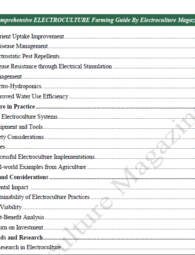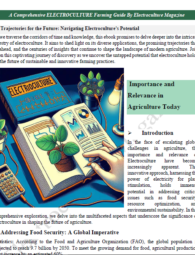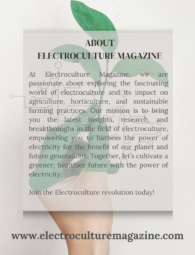Welcome to Electroculture Magazine, where we uncover the electrifying world of innovative agriculture techniques. Today, we’re diving into the captivating realm of Electroculture – a cutting-edge method poised to reshape sustainable farming for better future.
Electroculture is captivating farmers and scientists alike with its potential to revolutionize agriculture. This groundbreaking technique involves applying controlled electrical currents to plants and soil, sparking remarkable enhancements in growth and sustainability. By stimulating root development and nutrient absorption, Electroculture offers a path to higher yields and healthier crops.
Electroculture is an experimental agricultural technique that involves applying low-voltage electrical currents to plants and soil. Advocates believe these currents can enhance plant growth, nutrient uptake, and overall crop productivity. While some studies suggest potential benefits, the scientific consensus is limited due to a lack of robust evidence. Electroculture remains a subject of research and debate within the agricultural community as its mechanisms and practical applications continue to be explored.
At Electroculture Magazine, we’re excited to explore the multifaceted benefits this technique presents. Beyond accelerated plant growth, Electroculture minimizes the need for chemical fertilizers and water resources. This eco-friendly approach aligns with modern agricultural aspirations, addressing concerns like soil degradation and water scarcity.
While skeptics remain, ongoing research is shedding light on Electroculture’s vast possibilities. As we strive for more efficient and sustainable farming practices, Electroculture emerges as a beacon of hope. Join us on this illuminating journey as we uncover the untapped potential of Electroculture, right here at Electroculture Magazine. Together, we’ll cultivate knowledge, sow inspiration, and spark a new era in agriculture.
About Electroculture
The term “electroculture” refers to methods of increasing crop growth and yield through the use of electricity, such as maintaining an electric charge on a network over the plants or passing an electric current through the soil in which they are growing.
Over the past 70-80 years, numerous electroculture experiments have been conducted with varying levels of sophistication. Some of these experiments have suggested that electrical treatment can significantly increase crop yield, while others have failed to show any discernible response.
The study of electroculture literature does not include studies on the cultivation of plants under electric lighting, as the heat and light produced by the electrical energy, which is what causes the plants to respond under such conditions, account for the majority of their responses.
Normal Atmospheric Electrical Conditions
It is important to briefly describe the normal electrical conditions in the atmosphere, as the use of a charged network over growing plants changes the electrical state of the environment surrounding the plants.
On a clear day, there is a force that pushes a positively charged object downward; in other words, the electrical field of force is the same as what would exist if the earth were negatively charged.
On clear days, the potential gradient in the atmosphere is usually positive (a positive charge prefers to flow downhill), and the magnitude of the vertical gradient, although constantly changing, is on the order of 100 volts per meter. The potential gradient during thunderstorms can be either positive or negative and frequently changes direction. The magnitude of the potential gradient also varies greatly, typically reaching 10,000 volts per meter—100 times the typical gradient—during severe weather.
Further investigation of the lower atmosphere reveals the constant presence of charged particles or ions. There are both positive and negative ions, with the positive ions often being a little more prevalent. They are made up of collections of molecules that are electrically charged and loosely bonded. These small ions frequently join with dust particles to form large ions, which travel considerably more slowly than the small ions.
Electrical Conditions
When the potential gradient is positive, the positive ions go downhill to the ground while the negative ions move higher, creating an electric current that flows from the air to the earth. Since the mobility of the large ions is so low, their impact on the conductivity of the air can be ignored. This current is almost entirely caused by the small or free ions. Only 2 × 10^-12 amperes per square meter or 5 × 10^-10 amperes per acre is the amount of current flowing from the air to a unit area on the earth’s surface.
The strength of the current is related to the number of ions per unit volume, their mobility, and the potential gradient. The positive ions make up slightly more than half of the total amount of free ions, which is on the order of 1,000 per cubic centimeter. When exposed to a potential gradient of 100 volts per meter, their mobility allows them to move at a pace of around 1 centimeter per second.
Despite being extremely small on a per-area basis, the air-earth current is sufficient to reduce the earth’s negative charge to half its initial value in about ten minutes when applied to the entire surface. One of the unsolved issues in atmospheric electricity is the reason for the earth’s continued negative charge under such unusual circumstances.
Some Research on Electroculture
A group of scientists with ties to many institutes propose that electroculture can boost crop production. They conducted a study, published in the journal Nature Food, where they utilized conventional ways to cultivate peas while giving electric shocks to other pea crops. The study tested the notion of applying an electric current to plants while they develop to enhance yields.
However, skeptics have pointed out accusations of methodological shortcomings in this and previous studies. The team decided to forgo a double-blind design, which could have contributed to their findings being questioned. The team grew two plots of peas in a greenhouse, using identical sample pods. The crops were cared for under roughly identical circumstances, except that one plot’s plants were cultivated in an electric field.
You can also refer these Electroculture Books…
The scientists discovered that plants growing in the electric field generated around a fifth greater crop as the plants matured and produced new peas. The researchers assert that their findings demonstrate that electroculture operates as predicted, however they provided no justification for their claims.
It is noteworthy that the researchers used a novel strategy to create the electric field in the pea crop. Instead of obtaining it from the grid, they produced it locally using a triboelectric nanogenerator that was fueled by energy captured from wind and rainfall. They observed that this method only cost US $35-45.
They contend that this method might be applied immediately now to increase the amount of food available to the world’s expanding population. However, they do acknowledge that there might be some hesitation on the part of consumers who are concerned about potential health effects of the electric field on the crops.
The most recent electroculture research is still in its early phases, but there is some indication that it can be a useful technique to boost plant growth and production.
According to a recent research published in the journal Nature Food in 2022, electroculture can enhance pea output by up to 20%. The researchers created an electric field in the soil surrounding the pea plants using a triboelectric nanogenerator. They discovered that an electric field encouraged the growth of the plants’ roots and shoots, resulting in higher yields.
Another research, published in the journal Scientific Reports in 2021, discovered that tomato electroculture might increase nutritional quality. For ten days, the researchers administered an electric field to the soil around tomato plants 24 hours a day. They discovered that electrocultured tomatoes had greater amounts of antioxidants and other nutrients than control plants.
According to these findings, this technology has the potential to be a viable new method for increasing agricultural yields and quality. More study is needed, however, to validate these findings and optimise the conditions for electroculture.

Here are some more topics of research:
- The impact of various electric fields on plant development.
- The ideal electroculture voltage, current, and frequency.
- The time spent exposed to electric fields.
- The impact of electroculture on various plant species.
- Electroculture’s impact on soil health.
- Electroculture’s economic viability.
We should expect to learn more about the potential benefits of electroculture and how it might be utilised to boost agricultural productivity as research in this field progresses.
Benefits of Electroculture
Electroculture, a pioneering agricultural technique, offers a host of benefits that could revolutionize modern farming:
- Enhanced Plant Growth: By applying controlled electrical currents, this technology stimulates root growth and nutrient absorption, resulting in faster and healthier plant development.
- Reduced Chemical Usage: With improved nutrient uptake, plants grown through Electroculture require fewer chemical fertilizers, promoting eco-friendly and sustainable farming practices.
- Water Efficiency: Electroculture’s ability to enhance water absorption means crops can thrive with reduced water consumption, mitigating water scarcity concerns.
- Soil Health: The technique improves soil structure and microbial activity, leading to healthier soils and enhanced long-term fertility.
- Crop Yield Increase: Studies suggest that Electroculture can boost crop yields significantly, contributing to food security in a growing global population.
- Energy Savings: Despite its electrical component, Electroculture can lead to energy savings due to reduced reliance on chemical inputs and improved resource efficiency.
- Adaptability: This method allows crops to flourish in various environmental conditions, including arid and nutrient-poor soils.
- Environmental Friendliness: By minimizing chemical runoff and pollution, Electroculture supports more sustainable ecosystems and reduces the environmental impact of agriculture.
Embracing this technology could lead us towards a future of abundant harvests, reduced environmental strain, and more resilient agriculture systems.






